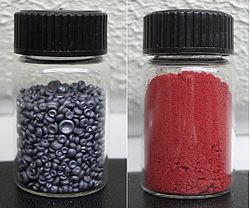Selenium
Selenium is found impurely in metal sulfide ores, where it partially replaces the sulfur. Commercially, selenium is produced as a byproduct in the refining of these ores, most often during copper production. Minerals that are pure selenide or selenate compounds are known, but are rare. The chief commercial uses for selenium today are in glassmaking and in pigments. Selenium is a semiconductor and is used in photocells. Uses in electronics, once important, have been mostly supplanted by silicon semiconductor devices. Selenium continues to be used in a few types of DC power surge protectors and one type of fluorescent quantum dot.
Selenium salts are toxic in large amounts, but trace amounts are necessary for cellular function in many organisms, including all animals. Selenium is a component of the antioxidant enzymes glutathione peroxidase and thioredoxin reductase (which indirectly reduce certain oxidized molecules in animals and some plants). It is also found in three deiodinase enzymes, which convert one thyroid hormone to another. Selenium requirements in plants differ by species, with some plants requiring relatively large amounts, and others apparently requiring none.
Occurrence
Native (i.e., elemental) selenium is a rare mineral, which does not usually form good crystals, but, when it does, they are steep rhombohedra or tiny acicular (hair-like) crystals. Isolation of selenium is often complicated by the presence of other compounds and elements.
Selenium occurs naturally in a number of inorganic forms, including selenide-, selenate-, and selenite-containing minerals, but these minerals are rare. The common mineral selenite is not a selenium mineral, and contains no selenite ion, but is rather a type of gypsum (calcium sulfate hydrate) named like selenium for the moon well before the discovery of selenium. Selenium is most commonly found quite impurely, replacing a small part of the sulfur in sulfide ores of many metals.
In living systems, selenium is found in the amino acids selenomethionine, selenocysteine, and methylselenocysteine. In these compounds, selenium plays a role analogous to that of sulfur. Another naturally occurring organoselenium compound is dimethyl selenide.
Certain solids are selenium-rich, and selenium can be bioconcentrated by certain plants. In soils, selenium most often occurs in soluble forms such as selenate (analogous to sulfate), which are leached into rivers very easily by runoff.[35][36] Ocean water contains significant amounts of selenium.
Anthropogenic sources of selenium include coal burning and the mining and smelting of sulfide ores.
| Symbol | Se | |
| Atomic Number | 34 | |
| Atomic Weight | 78.96 | |
| Oxidation States | +4,+6,-2 | |
| Electronegativity, Pauling | 2.55 | |
| State at RT | Solid, Nonmetal | |
| Melting Point, K | 490 | |
| Boiling Point, K | 958.1 |
Appearance and Characteristics
Harmful effects:
Elemental selenium’s oral LD50 (the single dose needed to kill 50% of those exposed) is 6700 mg kg-1 in rats; this is similar to ethanol, which is 7000 mg kg-1. These levels are classed as non-toxic.
Selenium’s legal airborne permissible exposure limit (PEL) is 0.2 mg m-3 averaged over an 8-hour shift. The EPA describes selenium as not classifiable for human carcinogenicity. Selenium sulfide is a probable carcinogen.
Many of selenium’s compounds, such as selenates and selenites, are highly toxic.
Hydrogen selenide gas (SeH2) is selenium’s most acutely toxic compound.
Characteristics:
- Selenium exists in several allotropic forms. The most stable form, crystalline hexagonal selenium, is metallic gray. Crystalline monoclinic selenium is a deep red color. Amorphous selenium is red in powder form and is black in vitreous form.
- Gray crystalline ‘metallic’ selenium conducts electricity better in the light than in the dark (photoconductive) and it can convert light directly into electricity (photovoltaic).
- In the same way as sulfur forms sulfides, sulfates, and sulfites, selenium combines with metals and oxygen to form selenides, (such as zinc selanide, ZnSe), selenates, (such as calcium selenate, CaSeO4), and selenites (such as silver selenite, Ag2SeO3).
- Although hydrogen selenide gas (SeH2) is highly toxic, it’s unlikely you’ll hang around long enough to be poisoned; it has a disgusting smell. Oliver Sacks said, “Hydrogen selenide, I decided, was perhaps the worst smell in the world.” (8)
Uses of Selenium
- Selenium is used in the glass industry to decolorize glass and to make red-colored glasses and enamels.
- It is used as a catalyst in many chemical reactions.
- Selenium is used in solar cells and photocells – in fact the first solar cell was made using selenium. It is also used as a photographic toner.
- Selenium is used with bismuth in brasses and as an additive to stainless steel. When selenium is added to iron and copper based metals it improves their machinability.
- Selenium sulfide is used in anti-dandruff shampoos.
- Despite the toxicity of its compounds, selenium is also an essential trace element for humans and other animals. Without it, the enzyme glutathione peroxidase (GPX), which protects against oxidative damage in cells, could not function. Abnormally low selenium in the diet might increase the risk of cancer. Abnormally high levels of selenium compounds can lead to selenium poisoning.
- Plants do not appear to need selenium, but they do need sulfur. When selenium is present in soils, it is used by plants as if it were sulfur, introducing selenium into food chains. In soils with low sulfur content, some plants can have high levels of selenium compounds. Animals that eat these plants may suffer ill-health.
- Selenium deficiency in animals can lead to slow growth and reproductive dysfunction.
